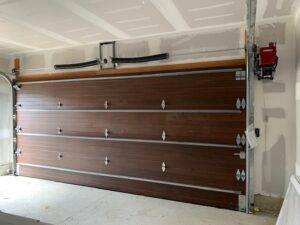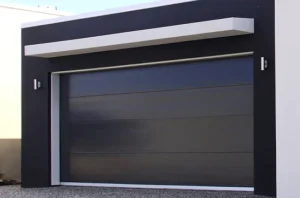The safety of your family and the safety of your garage are of utmost importance when repairing a garage door.
You probably don’t think twice about garage door springs when they break. There is nothing worse than being stuck in the garage with a garage door that won’t open and a car that can’t drive you to work.
When a garage door spring breaks, you can either call a professional or replace it yourself. In contrast, replacing the spring yourself can cost $30 to $100, while hiring a pro can cost $200 to $300. Although you may save a few bucks by replacing the spring yourself, hiring a professional will protect you from the dangers involved in this task, especially if you aren’t experienced.
You may want to tackle the project on your own or know more about it before deciding whether to call a professional or visit a hardware store. Here are three tips.
1. Be familiar with the types of garage door springs.
Make sure you know what type of garage door spring to replace before you begin. In general, there are two types of springs:

Extension Springs
An extension spring is long and skinny, consisting of parallel springs extending or stretching when the door is moved. Clipped-end, double-looped, and open-looped cables are available.
- Clipped-end extension springs are the most reliable. In addition to being stronger, they are used on garage doors weighing more than 200 pounds.
- Open-looped extension springs feature one coil at the end, connected to the pulley and eyebolt. Double-looped extension springs are stronger than open-looped springs.
- The open-looped extension spring is the weakest type of extension spring as it relies on an open wire at the end. Regardless of whether this is the only faulty component, the entire spring must be replaced if the wire is broken.
Torsion Springs
Torsion springs can be used on garage doors of various sizes, weights, and strengths. There is a large spring above the door opening on a metal shaft. A metal shaft is fitted with aluminum drums, and springs are wound to a specific torsion setting as the assembly moves. Early-set springs, Standard springs, torque-master springs, and steel rolling doors are a few examples.
- Early-set torsion springs are like standard torsion springs, except they are found in the middle of the torsion shaft.
- Standard torsion springs are generally found on residential garage doors with lightweight doors that only need a single spring to be effective.
- Torque-master torsion springs are closed in the torsion shaft and a winding cone on end to the torsion rod that holds it in place.
- Steel rolling doors torsion springs are often found in industrial and commercial buildings. The springs are located inside of a torsion barrel.
Replacement springs used in residential applications tend to be extension springs or torsion springs with an early-set or standard setting. Industrial and commercial garage doors usually use torque-master springs and steel rolling doors.
2. Replacement springs can be purchased online or from hardware stores or manufacturers.
If you have taken measurements and determined the type of spring you want beforehand, finding a replacement spring shouldn’t be difficult. A variety of hardware stores, including Lowe’s and The Home Depot, sell torsion and extension springs. If you are unsure of what you need, a spring manufacturer or a professional garage door company may be a better option. The springs they carry will likely be precisely what you need, and they will be able to answer any questions before you begin your project.
To ensure there is no discrepancy with parts once they are on-site, it is best to have the professionals bring their materials.
3. Care and caution should be exercised by DIYers.
There are two garage door springs, extension springs, and torsion springs, based on their hazards.
With basic garage door knowledge, extension springs can be replaced relatively easily by a DIYer. Falling garage doors, opening openers that activate during replacement, and minor cuts from rusted or old metal are dangers to be aware of during this replacement.
A torsion spring is a heavy metal spring that is under great tension. If a spring or winding cone breaks, flying metal can result. Minor or severe cuts are possible, garage doors can fall, and openers can be activated when replacing springs.
Unless you’re a very experienced DIYer, torsion spring replacement is best left to the pros unless you’re replacing either type of garage door spring on your own.
4. Follow these steps to replace the extension springs on a garage door.
The replacement of extension springs is one of the most common DIY projects, as it is a relatively safe and straightforward procedure without the danger of managing spring tension. Following are the steps for replacing an extension garage door spring.
- Remove all spring tension from the garage door and clamp it in place. After a garage door opener has been installed, disconnect it.
- Place a small piece of tape on the existing pulley so you can reinstall it exactly where it is.
- Remove the spring from the brackets and the pulley.
- The spring is held in place by a safety cable that runs through it.
- You need to disconnect the safety cable and take out the old spring.
- Find out which spring needs to be replaced. Color-coding has been applied to extension springs to indicate how much weight they can lift. To determine what color spring to purchase, reference the current spring:
- Tan: 100 pounds
- White: 110 pounds
- Green: 120 pounds
- Yellow: 130 pounds
- Blue: 140 pounds
- Red: 150 pounds
- Brown: 160 pounds
- Orange: 170 pounds
- Gold: 180 pounds
- Light Blue: 190 pounds
- Replace the old spring with a new one that matches the old one.
- Attach the new spring to the track bracket by threading the safety cable through it.
- Ensure that the pulley wire does not touch the safety cable when you reconnect the safety cable and pulley. Be sure to install the pulley in the right place using the tape you placed before you decide to remove the pulley.
- The garage door opener must be connected after the clamps are removed.
- Verify that the replacement worked by testing the garage door. You need to adjust the extension spring hardware and the pulley if the door won’t close or closes too fast.
5. These steps will explain how to replace garage door torsion springs.
It is more dangerous and challenging to replace torsion springs. Experienced DIYers should only attempt the following steps. Exercise extreme caution when completing steps 2 and 3, as well as steps 13 through 16. When in doubt, hire a professional.
- The tension on the springs can’t open the door when the opener is unplugged and crated to the track.
- A sturdy ladder is required to reach the end of the spring beside the winding cone. The spring can be held in place with a winding bar. When you remove the winding bar from the cylinder, push it up one-quarter turn and then bring it back down to evaluate how much force is needed. To loosen the screw set, loosen the grip with the winding bar.
- To avoid being injured by the cone quickly unwinding, leave one bar in it at all times.
- Place a second winding bar below the first winding bar, then lower the garage door to the top.
- Put the second winding bar into the next hole, then remove the first winding bar. Completely unwind the spring by repeating steps 4 and 5.
- Disconnect the torsion cones from the center stationary cones, then remove the torsion cones.
- Spring, cable, and cable drums should be removed.
- To find out if the spring turns right or left for torsion springs, measure the wire size, inside diameter (most springs have a two-inch inside diameter), and spring length.
- Replace the old spring with a new one that is identical in type, size, and orientation to the old spring.
- Reinstall the cable drum after installing the new left spring on the torsion tube, stationary cone facing the center bracket.
- Secure the cones after installing the center bearing and the new right spring.
- Cables should be threaded, and drums should be tightened. To keep the door from opening unevenly, ensure the tension is even on both sides.
- Wind the spring using the winding bars in the opposite direction as it was unwound. Ensure that the winding cone always has at least one winding bar.
- Follow the manufacturer’s recommendations for how many turns to wind the spring.
- The spring can be stretched out by 1/4 inches with a hammer.
- On the winding cone, tighten the set screws.
- Garage door lubricant should be used to lubricate the spring, and then the garage door should be removed.
- Lift the door about three feet to test the spring. The door should remain in place if the replacement is successful. A quarter turn on the spring will make the door stay open if the door falls. The door must remain closed if you loosen the spring a quarter turn.



